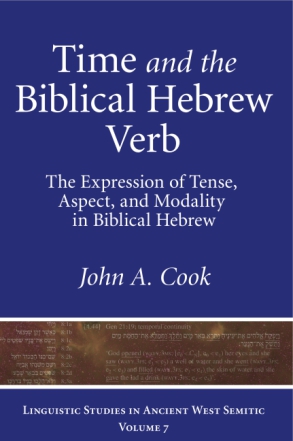
Time and the Biblical Hebrew Verb
The Expression of Tense, Aspect, and Modality in Biblical Hebrew
John A. Cook
Time and the Biblical Hebrew Verb
The Expression of Tense, Aspect, and Modality in Biblical Hebrew
John A. Cook
In this book John Cook interacts with the range of approaches to the perennial questions on the Biblical Hebrew verb in a fair-minded approach. Some of his answers may appear deceptively traditional, such as his perfective-imperfective identification of the qatal–yiqtol opposition. However, his approach is distinguished from the traditional approaches by its modern linguistic foundation. One distinguishing sign is his employment of the phrase “aspect prominent” to describe the Biblical Hebrew verbal system. As with almost any of the world’s verbal systems, this aspect-prominent system can express a wide range of aspectual, tensed, and modal meanings. In chap. 3, he argues that each of the forms can be semantically identified with a general meaning and that the expressions of specific aspectual, tensed, and modal meanings by each form are explicable with reference to its general meaning. After a decade of research and creative thinking, the author has come to frame his discussion not with the central question of “Tense or Aspect?” but with the question “What is the range of meaning for a given form, and what sort of contextual factors (syntagm, discourse, etc.) help us to understand this range in relation to a general meaning for the form?” In chap. 4 Cook addresses long-standing issues involving interaction between the semantics of verbal forms and their discourse pragmatic functions. He also proposes a theory of discourse modes for Biblical Hebrew. These discourse modes account for various temporal relationships that are found among successive clauses in Biblical Hebrew. Cook’s work addresses old questions with a fresh approach that is sure to provoke dialogue and new research.
- Description
- Table of Contents
Preface
Acknowledgments
Abbreviations and Symbols
Chapter 1.A Theory of Tense, Aspect, and Modality
1.1.Pre-modern Treatments of Tense and Aspect
1.2.The R-Point and Modern Tense Theory
1.3.A Primer on Aspect
1.4.The R-Point in Tense-Aspect Theory
1.5.The R-Point and Discourse
1.6.A Primer on Modality
1.7.A Model of Tense, Aspect, and Modality
1.8.Conclusion
Chapter 2.Tense, Aspect, and Modality in Biblical Hebrew
2.1.A Primer on the Biblical Hebrew Verbal System
2.2.The Establishment of the “Standard” Theory of the Biblical Hebrew Verbal System
2.3.The Biblical Hebrew Verbal System in Historical and Comparative Perspective
2.4.Biblical Hebrew Verb Theory in the Last Half Century
2.5.Hebrew Verb Theory at the Beginning of the 21st Century
Chapter 3.The Semantics of the Biblical Hebrew Verbal System
3.1.Theoretical Considerations
3.2.The Expression of Aspect in BH
3.3.The Expression of Modality in BH
3.4.The Expression of Temporality in BH
3.5.The TAM System of BH in Diachronic-Typological Perspective
Chapter 4.Semantics and Discourse Pragmatics of the Biblical Hebrew Verbal System
4.1.On Discourse-Pragmatic Approaches to BH
4.2.Some Elements of Discourse Structure
4.3.The Semantics of Temporality in BH Discourse
4.4.The Temporal and Modal Interpretation of Discourse
4.5.Conclusion
Works Cited
Indexes
Index of Authors
Index of Scripture
Mailing List
Subscribe to our mailing list and be notified about new titles, journals and catalogs.




